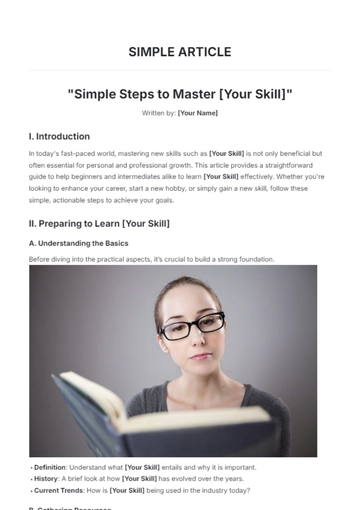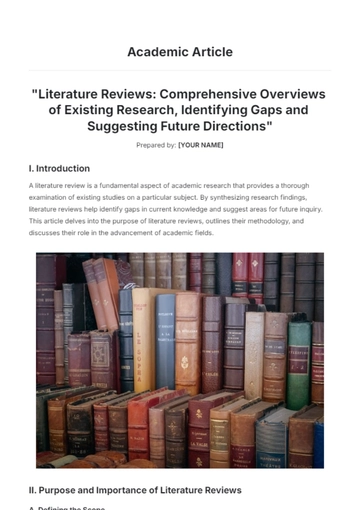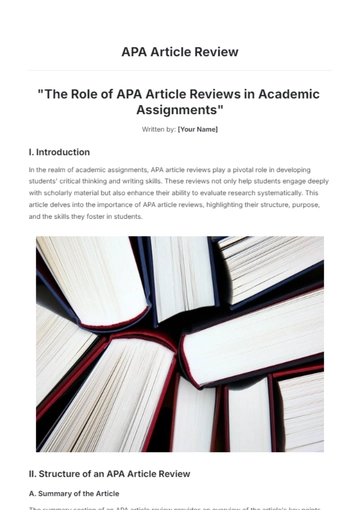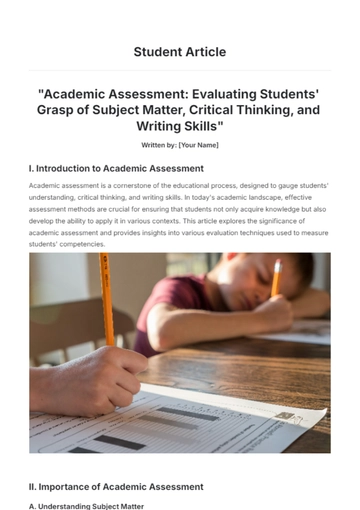Free Teacher Article

"Mastering Classroom Management"
Prepared by: [Your Name]

I. Introduction
Effective classroom management is the cornerstone of successful teaching. As teachers strive to create engaging learning environments, mastering classroom management techniques becomes paramount. This article aims to provide educators with a comprehensive guide to classroom management strategies, tips, and best practices.

II. Understanding Classroom Dynamics
In order to effectively manage a classroom, teachers must first understand the dynamics at play. Every classroom is unique, with its own set of challenges and opportunities. Factors such as class size, student demographics, and learning styles all influence classroom dynamics. By taking the time to observe and assess these factors, teachers can tailor their management approach to meet the specific needs of their students.
III. Establishing Clear Expectations
One of the key components of successful classroom management is the establishment of clear expectations. Teachers should communicate their expectations regarding behavior, academic performance, and classroom procedures from the very beginning of the school year. This helps create a sense of structure and predictability, leading to a more positive and productive learning environment.
A. Creating a Classroom Code of Conduct
Involve students in the creation of classroom rules to foster a sense of ownership and accountability.
Clearly outline consequences for both positive and negative behavior.
Display the classroom code of conduct prominently in the classroom for reference.
B. Consistency is Key
Enforce rules consistently and fairly to maintain credibility and trust with students.
Be proactive in addressing behavior issues before they escalate, and follow through with consequences as needed.

IV. Building Positive Relationships
Building positive relationships with students is essential for effective classroom management. When students feel respected, valued, and connected to their teacher, they are more likely to be engaged and cooperative.
A. Getting to Know Your Students
Take the time to learn about each student's interests, strengths, and challenges.
Use icebreakers and team-building activities to foster a sense of community in the classroom.
B. Providing Individualized Support
Recognize and celebrate student achievements and progress.
Offer support and encouragement to students who are struggling academically or behaviorally.
V. Implementing Effective Instructional Strategies
In addition to managing behavior, teachers must also focus on delivering high-quality instruction. Effective instructional strategies can help engage students and minimize disruptions in the classroom.
A. Differentiated Instruction
Differentiate instruction to meet the diverse needs of students.
Use a variety of teaching methods and instructional materials to accommodate different learning styles.
B. Active Learning Techniques
Incorporate hands-on activities, group work, and discussions to keep students actively engaged in the learning process.
Provide opportunities for students to demonstrate their understanding through projects, presentations, and other creative assessments.
VI. Conclusion
Mastering classroom management is an ongoing process that requires patience, flexibility, and dedication. By implementing the strategies outlined in this article, teachers can create a positive and productive learning environment where all students can thrive. With clear expectations, positive relationships, and effective instructional strategies, teachers can successfully manage their classrooms and help students reach their full potential.
About the Author:
About the Author
[Your Name], an experienced educator and content creator at [Your Company Name], is passionate about empowering teachers with practical strategies for classroom success. With a background in education and a knack for writing engaging content, [Your Name] strives to provide valuable resources and insights to educators worldwide. Through years of teaching experience and dedication to professional development, [Your Name] is committed to supporting teachers in their journey to create dynamic and effective learning environments.
- 100% Customizable, free editor
- Access 1 Million+ Templates, photo’s & graphics
- Download or share as a template
- Click and replace photos, graphics, text, backgrounds
- Resize, crop, AI write & more
- Access advanced editor
Unlock your teaching potential with the Teacher Article Template from Template.net. This meticulously crafted resource offers educators a seamless blend of innovation and efficiency. Fully editable and customizable, it harnesses the power of our AI Editable Tool to streamline lesson planning and content creation. Elevate your teaching experience with this indispensable tool tailored for modern educators.





























